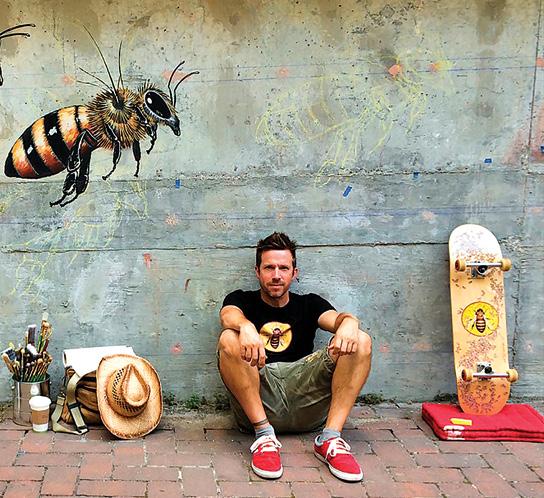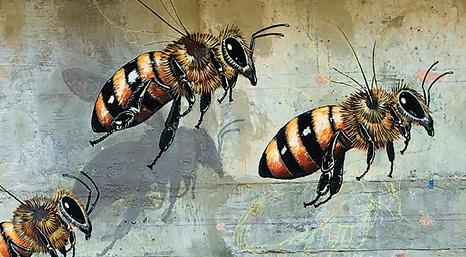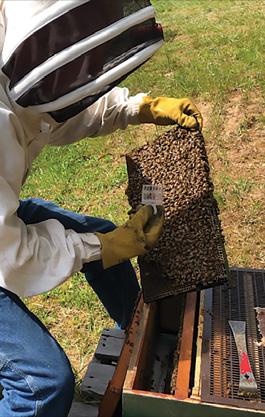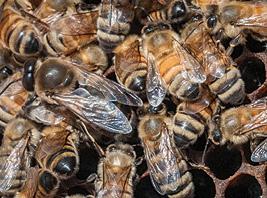
5 minute read
Mayland’s Earth to Sky Park | By Elizabeth Baird Hardy

Muralist Matt Willey Matt Willey sketches out a scout bee

Mayland’s Earth to Sky Park: Bee-coming the Place to Bee!
By Elizabeth Baird Hardy
On a sunny day in May 2021, a honeybee landed on a building. That doesn’t seem like such a newsworthy item, except for the fact that the building is the Paul and Susie O’Connell Conference Center at Mayland Community College’s Earth to Sky Park (ESP), and the honeybee is a scout bee, painted by muralist Matt Willey to herald the forthcoming arrival of a full mural of honeybees. In October, that single honeybee will be joined by her hive mates, who will join part of a worldwide program aimed at promoting these valuable pollinators.
The Glenn and Carol Arthur Planetarium is the canvas for the mural, which, like all of the pieces in Willey’s stunning The Good of the Hive series, celebrates not just the honeybee, but the connectedness of all living things. Since the dome of the planetarium is made up of triangular panels that resemble a honeycomb, the bee mural is a most apt choice to decorate the building, which will host a wide variety of events. When the weather or time of day is not conducive to stargazing through the telescopes of the Bare Dark Sky Observatory, guests to the Earth to Sky Park can explore the heavens and even travel through time within the planetarium. With new events and activities at the park, along with the opening of the first group of rooms at the new Blue Ridge Boutique Hotel, more guests will have the opportunity to explore the worlds all around us.
Gazing at the stars often reminds us of our place in the universe, helping us put into perspective our individual concerns within the larger scope of a giant universe. The mural, along with the pollinator gardens and other “earth-bound” features of the ESP, can remind us of our connectedness to the small as well as to the large. One of Willey’s primary purposes in creating the murals has been to help us, as humans, see how we are connected to our world and to each other.
That lovely scout bee, eagerly awaiting her kin, is a reminder that honeybees are not independent creatures. The organism is the hive, not the individual bee, who functions much more like a cell in a body than as a single creature. Honeybee hives, consisting of one queen, thousands of worker bees, and up to a thousand drones, require everyone working together to thrive. Certainly, humans are not honeybees (worker bees die when they can no longer work, and those hapless drones are eliminated at the end of summer to conserve resources for the winter), but these remarkable creatures serve to remind us of the interconnectedness of everything and everyone. They are managed by humans, like those of us who “collect the rent” in honey and provide them with a hive and protection from some threats, but honeybees are not tamed. As William Longgood points out beautifully in The Queen Must Die: And Other Affairs of Bees and Men (1985), bees “are one of our few remaining links with unspoiled nature” (227).
Willey’s quest to paint 50,000 bees (the estimated number for a healthy hive) around the world began five years ago, and, with the mural on the Arthur Planetarium, an important milestone will be reached. Willey will paint his ten-thousandth bee. In celebration of that achievement, the mural at the ESP will be featured in the first episode of a forthcoming streaming series on Willey’s journey with The Good


Planetarium as of August 2021 Art Rendering of Planetarium

of the Hive. In addition, the ESP will host Bee Fest on October 23, featuring beekeepers, bee-themed vendors, and, of course, honey. The event is an opportunity to celebrate all things related to honeybees, while also giving visitors the chance to see Willey at work, ask questions, and learn a little more about our fellow travelers on the earth, the industrious and elegant honeybees.
The mural will take Willey six weeks to complete, and visitors are welcome to watch the remarkable process of turning a building into bees. Although Willey will continue on his journey to paint 40,000 more bees and to encourage greater co-operation among humans, the scout bee, the mural, and the ten-thousandth bee will remain at the ESP to welcome visitors to the Planetarium and to encourage them to look up, down, and around to better understand and connect with everything and everyone around us.

To learn more about Willey’s work, visit www. thegoodofthehive.com. To learn more about the Earth to Sky Park, including the Glenn and Carol Arthur Planetarium, visit: www.mayland.edu/foundation/ foundation-projects/earth-to-sky-park/ or www. mayland.edu/planetarium/
Richard F. Baker

Photo by Lance Cheung, USDA
Local Beekeeper Leaves Behind Legacy
Richard F. Baker was the kind of beekeeper who cared for other keepers as well as for bees. When Richard passed away last year, he left behind his wife, Dee, and their two young daughters, Loren and Leah. He also left behind his bees and many humans who had learned to care for bees thanks to his encouragement. In addition to enjoying working on beekeeping with his family, Richard was a wealth of knowledge to new beekeepers. When I became a “surprise” beekeeper with inhabitants in a seemingly abandoned old hive, Richard was there to help and answer my questions.
Even after his passing, Richard is still helping to spread the love and knowledge of bees. The Toe Cane Beekeepers Association (TCBA) family is proudly supporting the Richard F. Baker Beekeeping Scholarship for students at Mayland Community College. Each semester, the TCBA will sponsor a student in Richard’s name. To learn more about the scholarship, please visit https://toecanebeekeepers.net/ memorial/. To learn more about scholarship opportunities at Mayland, visit www.mayland. edu/mcc-scholarship-program/.










